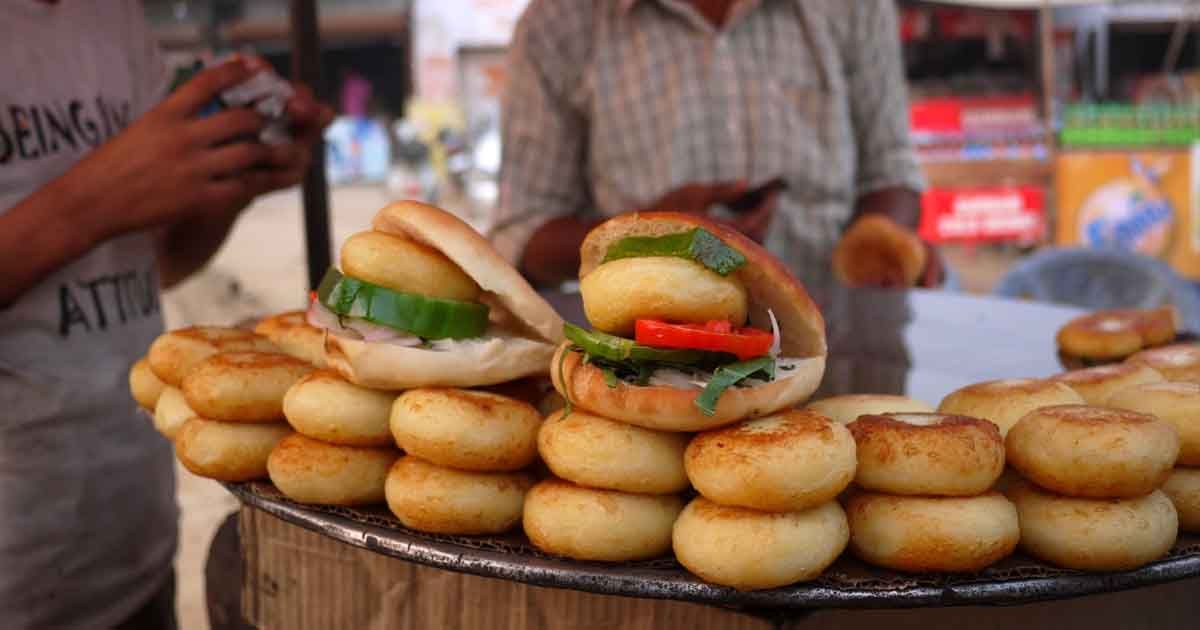Indian cuisine is ancient, distinct, and steeped in tradition. A fusion of ethnic influences, much like the country itself. It reflects an 8,000-year history of various cultures interacting with the subcontinent, leading to a multiplicity of flavours and provincial dishes unearthed in present-day India. Cuisine contrasts across India’s regions as a result of variation in local culture and geography.
Indian cuisine has gained a primary place, especially in the Western world as a result of globalization and other factors such as immigration and accessibility of recipes online. From ‘butter chicken’ becoming the national dish of the United Kingdom, to many Indian dishes materializing on international flights, Indian food items have secured their place on the new global menu.
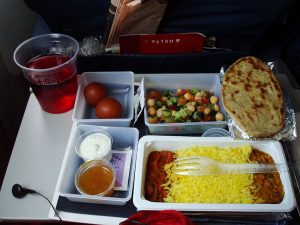
That being said, the spicy food presented at buffets in many western countries, or the commonplace “curry” in Britain are only a fraction of the array and quality Indian cuisine has to offer. Growing up in the cultural hub that is South Africa, I was no stranger to Indian food – in fact, I enjoyed it so much my parent’s used to joke that I should marry an Indian. Suffice it to say, on our first date my husband ordered dal gosht – and the rest is history! That was the day I fell in love with Indian food – and him of course!
The full-bodied spices, rich flavours, complex technique, and surprising textures all make up the bases of Indian cuisine – but most of all it’s the passion that lingers on your taste buds. Although, for myself spices are the main reason I am drawn to Indian food culture – raised in an English household, many times salt and pepper are the only seasoning one used. Now I have a spice craving that can never be cured – I put chilies in every dish, and appreciate well-seasoned dishes much more. Spices are the be all and end all. The blend should be just right. My mother-in-law is no exception, she uses a special masala wala – as I dubbed them, and now I only use traditional Indian spices – and will even courier them to South Africa for myself and my family. I’ve become a real spice snob, but it truly is an integral part of Indian food.
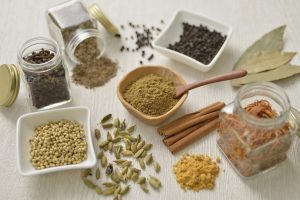
Many foodies are adamant on sectioning and labelling their food as South Indian or Kashmiri, and while I appreciate the region, culture, and history behind the dish, I feel that the Indian culinary experience is a journey that won’t ever come to an end, with many roads interconnected to each other. So to my heart and stomach, it makes sense to have a fusion – much like India – appropriately called “Traditional Favourites”, where I list food that impacted my taste buds and soul.
Traditional Favourites:
Idli and appam – the two best things to come out of South India! When my husband and I were living in Dubai we frequented this little South Indian restaurant, and I think many times we ate our way into their profit margins.
Idli are a type of savoury rice cake, popular as a breakfast food – although many don’t limit this delicacy to morning hours. The cakes are made by steaming a batter of lentils and rice. Idli is traditionally served with a steaming bowl of sambhar – a lentil based stew – and copious amounts of coconut chutney. While appam is a savoury pancake made with fermented rice batter and coconut milk and shaped like a bowl. It mops up gravies like a dream!

Banana Leaf in Andheri, Mumbai, is easily one of the most traditional South Indian restaurants I’ve visited – if you’re looking for some scrumptious South Indian food – this is the place to go!
My husband is half Gujju – so you know he married a girl with an appetite! I love a traditional Gujarati breakfast, which is an interesting assortment of fresh dhokla, jalebi, and papdi. I must have mine with spicy papaya salad and green chilies! So let me break this down for those of you who – sadly – haven’t had the pleasure of eating this.
Dhokla is a vegetarian food made with a fermented batter of rice and split chickpeas. Fermented sounds strange – but it’s pure bliss! The only thing I can liken it to is a savoury sponge cake. It can be had for breakfast, as a main course, or as a snack. Jalebi is common to many South Africans, and is a traditional Indian sweet or mithai made from deep-fried flour batter in pretzel or circular shapes, that are then soaked in a sugar syrup. A mouthful of jalebi and then a bite of dhokla – and you’re in seventh heaven. While, papdi is a crispy fried wafer made from flour and oil – like crisps but better. I can’t wait to open up my little newspaper parcel of Gujarati breakfast when I’m next in India! I’m like a kid on Christmas morning.


Street food:
The only thing I love more than Indian food, is Indian street food! Allow me to explain – Indian street food is like a religion. It’s meticulous. People have snacks as dinner, at lunch breaks, between classes, or whenever humanly possible. And essentially, you have a go-to vendor for your street food. For instance, someone might make the best vada pav, but the next wala (vendor) has the best papdi chaat. Unsurprisingly, every store will have a line of customers, even on a quiet night. Now let’s dive into some of my favourite street food:
Pani Puri. For those who don’t know what that is. Please do yourself a favour and find some right now. Pani puri consists of a round, hollow, fried crisp that is filled with a concoction of flavoured water (pani), chutney, spices, and potato, onion or chickpeas. Everyone has their own pani puri wala (vendor), and its sacrilege to go to anyone else.
My husband’s pani puri wala is called Bharat – well, now he’s my wala too. I have a pani puri wala called “India” and I think that depicts Indian patriotism in a way that is honest yet poetic. Bharat has often asked my husband how I can eat so many puris. Well, Bharat, I’ve been eating pani puri for only two years of my life, and I need to catch up with the rest of India.
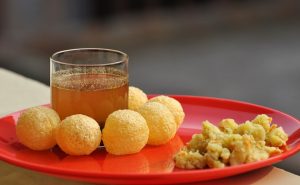
Pav Bhaji consists of a dense vegetable curry served with a soft bread roll (pav) pan-fried in butter. It has happened on many occasions that after a wild night out of bar hopping, I get a craving – only Amar Juice Centre can satisfy that craving! The best pit-stop I’ve ever made – sitting in a rickshaw munching on my pav bhabji! The pav is so buttery and as we say here – more-ish! (“More-ish” is a made-up English word used to describe the feeling you get when you eat something and find yourself going back for more!) I recently made it for my family in South Africa and needless to say I am living with pav bahji addicts.
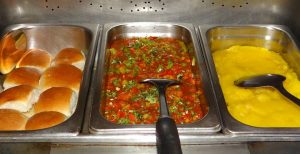
Vada Pav is addictive too! It’s a glorious creation affectionately known as the Bombay Burger. A deep fried potato dumpling cradled inside a fresh bun (pav), accompanied with spicy chutneys and chillies. It’s mouth-watering, and a favourite of mine because of how quick and easy it is to prepare and eat. One could easily devour a fresh vada pav, while strolling through the markets of Mumbai. I’m a fan of anything that allows me to multi-task!

Continental Food:
I have had some of my best foodie moments in India – and not all of them are Indian fares. In fact, the Indian restaurant scene boasts many traditional, fusion, and continental culinary experiences. I’ve had some of the best pizza in my life at Pizza By The Bay, in South Mumbai – I know, I’ve mentioned this before, but it’s that good! I’ve also visited some fascinating little Chinese restaurants boasting fusion flavours, a prominent one being: 5 Spice in Pali Hill, Bandra, with the most delectable peking rice!

One of the dives we frequent in Mumbai is actually a franchise, but this one in Bandra is our home away from homes. A quaint Irish pub, The Irish House, and believe me, it’s traditional. The music is great, the service is impeccable – the barmen have my glass of wine ready right after I enter – and the food is as the Irish would say “grand”!
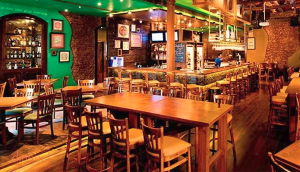
Indian cuisine is now considered my “home food”. I cook authentic dishes weekly – in fact, I crave Indian food more than hubby does. My family here in South Africa love sharing the tastes of India and hearing about my food stories. I can’t wait to explore more of India on my plate. Indian cuisine continues to evolve along with the culture and the people. The aromas waft around kitchens, filling restaurants and homes with their lingering scent – imprinting memories into both the hearts and stomachs of locals and foreigners alike.
————————————————————————————————————————————————————–
This article is last part of the series “Exploring India Through the Eyes of a South African”. Follow the below links to read other posts.
Part 3 : Indian Culture & Customs. https://blogsinmyemail.com/index.php/2018/02/24/exploring-india-eyes-south-african-indian-culture-customs
Part 2 : My experiences in India. https://blogsinmyemail.com/index.php/2018/02/14/my-experiences-in-india/
Part 1 : Places I visited. https://blogsinmyemail.com/index.php/2018/02/07/exploring-india-eyes-south-african-places-visited/
—————————————————————————————————————————————————————
